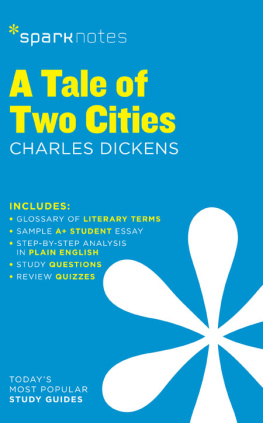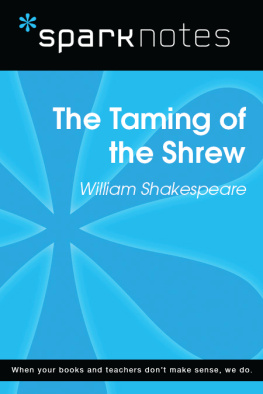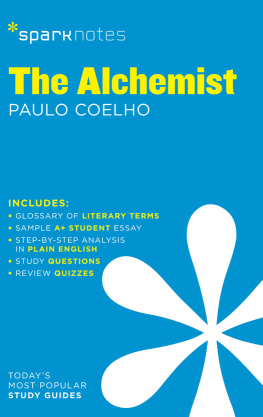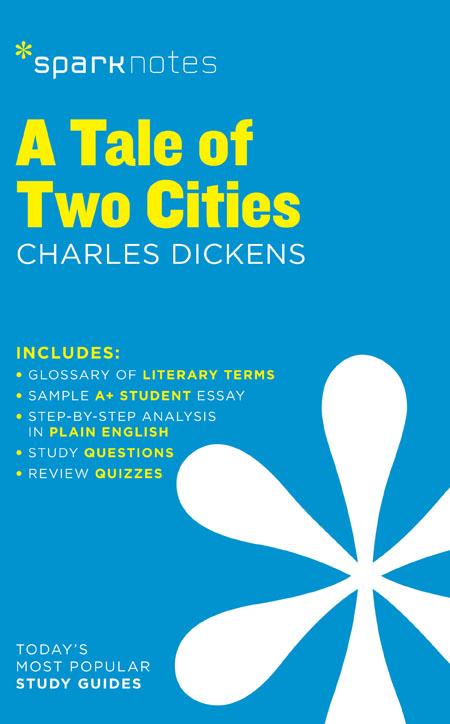A Tale of Two Cities
Charles Dickens
2003, 2007 by Spark Publishing
This Spark Publishing edition 2014 by SparkNotes LLC, an Affiliate of Barnes & Noble
All rights reserved. No part of this publication may be reproduced, stored in a retrieval system, or transmitted in any form or by any means (including electronic, mechanical, photocopying, recording, or otherwise) without prior written permission from the publisher.
Sparknotes is a registered trademark of SparkNotes LLC
Spark Publishing
A Division of Barnes & Noble
120 Fifth Avenue
New York, NY 10011
www.sparknotes.com /
ISBN-13: 978-1-4114-7190-0
Please submit changes or report errors to www.sparknotes.com/errors.
10 9 8 7 6 5 4 3 2 1
Context
C harles Dickens was born in Portsmouth, England in 1812 . As the second of eight children in a very poor family, he lived a difficult childhood. Eventually, his father was sent to debtors prison, and Dickens himself went to work at the age of twelve to help pay off the familys debt. This troublesome time scarred Dickens deeply and provided him with substantial material for such stories as Great Expectations, Oliver Twist, and David Copperfield. Steeped in social criticism, Dickenss writing provides a keen, sympathetic chronicle of the plight of the urban poor in nineteenth-century England. During his lifetime, Dickens enjoyed immense popularity, in part because of his vivid characterizations, and in part because he published his novels in installments, making them readily affordable to a greater number of people.
The Industrial Revolution, which swept through Europe in the late eighteenth century, originated in England. The rapid modernization of the English economy involved a shift from rural handicraft to large-scale factory labor. Technological innovations facilitated unprecedented heights of manufacture and trade, and England left behind its localized, cottage-industry economy to become a centralized, hyper-capitalist juggernaut of mass production. In tandem with this transformation came a significant shift in the nations demographics. English cities swelled as a growing and impoverished working class flocked to them in search of work. As this influx of workers into urban centers continued, the bourgeoisie took advantage of the surplus of labor by keeping wages low. The poor thus remained poor, and often lived cramped in squalor. In many of his novels, Dickens chronicles his protagonists attempts to fight their way out of such poverty and despair.
A Tale of Two Cities, originally published from April through November of 1859 , appeared in a new magazine that Dickens had created called All the Year Round. Dickens started this venture after a falling-out with his regular publishers. Indeed, this period in Dickenss life saw many changes. While starring in a play by Wilkie Collins entitled The Frozen Deep, Dickens fell in love with a young actress named Ellen Ternan. Dickenss twenty-three-year marriage to Catherine Hogarth had become a source of unhappiness in recent years, and, by 1858 , Hogarth had moved out of Dickenss home. The author arranged to keep Ternan in a separate residence.
Dickenss participation in Collinss play led not only to a shift in his personal life, but also to a career development, for it was this play that first inspired him to write A Tale of Two Cities. In the play, Dickens played the part of a man who sacrifices his own life so that his rival may have the woman they both love; the love triangle in the play became the basis for the complex relations between Charles Darnay, Lucie Manette, and Sydney Carton in A Tale of Two Cities. Moreover, Dickens appreciated the play for its treatment of redemption and rebirth, love and violence. He decided to transpose these themes onto the French Revolution, an event that embodied the same issues on a historical level. In order to make his novel historically accurate, Dickens turned to Thomas Carlyles account of the revolution. Contemporaries had considered Carlyles version to be the first and last word on the French peasants fight for freedom.
Dickens had forayed into historical fiction only once before, with Barnaby Rudge ( 1841 ), and the project proved a difficult undertaking. The vast scope and somewhat grim aspects of his historical subject forced Dickens largely to abandon the outlandish and often comic characters that had come to define his writing. Although Jerry Cruncher and Miss Pross embody some typically Dickensian quirksexaggerated mannerisms, idiosyncratic speechthey play only minor roles in the novel. While critics continue to debate the literary merits of the novel, no one denies the light that the novel sheds on Dickenss development as a novelist. More experimental than the novels that precede it, A Tale of Two Cities shows its author in transition. Dickens would emerge from this transition as a mature artist, ready to write Great Expectations ( 1860 1861 ) and Our Mutual Friend ( 1864 1865 ).
Plot Overview
T he year is 1775, and social ills plague both France and England. Jerry Cruncher, an odd-job man who works for Tellsons Bank, stops the Dover mail-coach with an urgent message for Jarvis Lorry. The message instructs Lorry to wait at Dover for a young woman, and Lorry responds with the cryptic words, Recalled to Life. At Dover, Lorry is met by Lucie Manette, a young orphan whose father, a once-eminent doctor whom she supposed dead, has been discovered in France. Lorry escorts Lucie to Paris, where they meet Defarge, a former servant of Doctor Manette, who has kept Manette safe in a garret. Driven mad by eighteen years in the Bastille, Manette spends all of his time making shoes, a hobby he learned while in prison. Lorry assures Lucie that her love and devotion can recall her father to life, and indeed they do.
The year is now 1780 . Charles Darnay stands accused of treason against the English crown. A bombastic lawyer named Stryver pleads Darnays case, but it is not until his drunk, good-for-nothing colleague, Sydney Carton, assists him that the court acquits Darnay. Carton clinches his argument by pointing out that he himself bears an uncanny resemblance to the defendant, which undermines the prosecutions case for unmistakably identifying Darnay as the spy the authorities spotted. Lucie and Doctor Manette watched the court proceedings, and that night, Carton escorts Darnay to a tavern and asks how it feels to receive the sympathy of a woman like Lucie. Carton despises and resents Darnay because he reminds him of all that he himself has given up and might have been.
In France, the cruel Marquis Evrmonde runs down a plebian child with his carriage. Manifesting an attitude typical of the aristocracy in regard to the poor at that time, the Marquis shows no regret, but instead curses the peasantry and hurries home to his chateau, where he awaits the arrival of his nephew, Darnay, from England. Arriving later that night, Darnay curses his uncle and the French aristocracy for its abominable treatment of the people. He renounces his identity as an Evrmonde and announces his intention to return to England. That night, the Marquis is murdered; the murderer has left a note signed with the nickname adopted by French revolutionaries: Jacques.
A year passes, and Darnay asks Manette for permission to marry Lucie. He says that, if Lucie accepts, he will reveal his true identity to Manette. Carton, meanwhile, also pledges his love to Lucie, admitting that, though his life is worthless, she has helped him dream of a better, more valuable existence. On the streets of London, Jerry Cruncher gets swept up in the funeral procession for a spy named Roger Cly. Later that night, he demonstrates his talents as a Resurrection-Man, sneaking into the cemetery to steal and sell Clys body. In Paris, meanwhile, another English spy known as John Barsad drops into Defarges wine shop. Barsad hopes to turn up evidence concerning the mounting revolution, which is still in its covert stages. Madame Defarge sits in the shop knitting a secret registry of those whom the revolution seeks to execute. Back in London, Darnay, on the morning of his wedding, keeps his promise to Manette; he reveals his true identity and, that night, Manette relapses into his old prison habit of making shoes. After nine days, Manette regains his presence of mind, and soon joins the newlyweds on their honeymoon. Upon Darnays return, Carton pays him a visit and asks for his friendship. Darnay assures Carton that he is always welcome in their home.

















